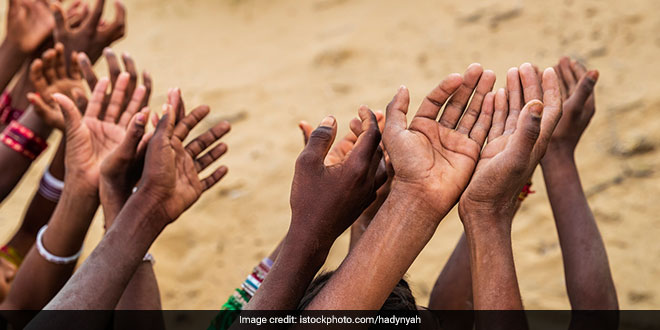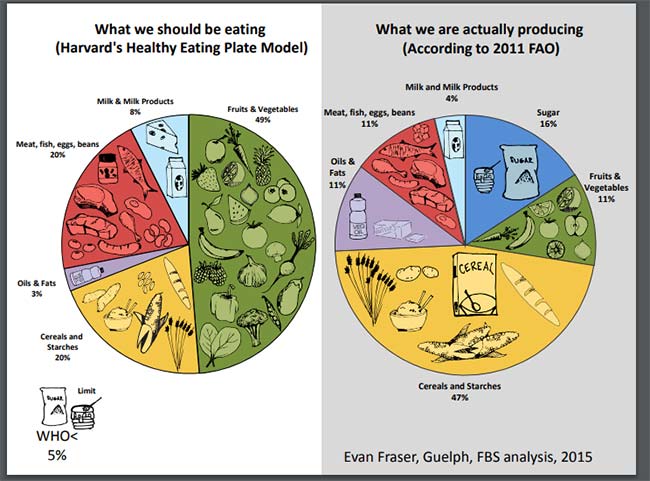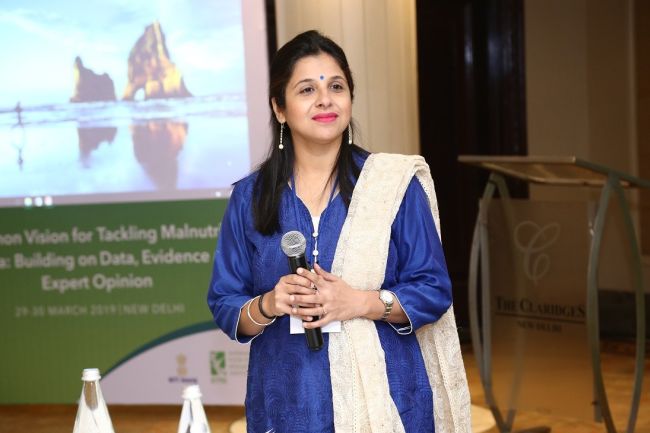Highlights
- In India, 23% of women and 20% of men age 15-49 are undernourished: NFHS-4
- 36 per cent of children under five years of age are underweight: NFHS-4
- Food is responsible for approximately 26% of global greenhouse gas emission
New Delhi: Food was the biggest worry during the lockdown for everyone- those who could afford were anxious about safe access and delivery of food items while for some, getting two meals a day was a big deal. While some were sharing recipes, cooking videos, others were scraping the pots to get any food in their hungry stomachs. Of course, the governments recognized this early on and announced several packages, organized mass feedings, provided access to subsidised or free meals. Even personal and institutional philanthropy helped many to survive this dark period. But a big question is why did we not plan for rainy days like this beforehand? Why was there so much chaos and unrest over a basic requirement that is food? Are our food systems inefficient or could this be averted or minimized by stronger, more robust food systems? Simply focusing on farm to fork did not help much when pandemics like COVID 19 struck. In fact, they merely laid open the gross inadequacies in our food system. And if we do not tighten our leaky cups now, we will run out of subsidies and free meals when the next one comes knocking our doors. I am not a pessimist; thus saying negative things pain me but my straightforwardness in this piece is only to express my concern about a disjointed siloed approach to fixing India’s hunger and malnourishment problems in both the short and long term. Before we move further, please note that in simple words the food system refers to a complex web of activities involving the production, processing, transport, and consumption.

During COVID-19 induced lockdown, various non-governmental organisations stepped up to distribute food
The unprecedented social, economic crisis triggered by the COVID-19 pandemic poses grave risks to the nutritional status and survival of young children especially in low-income and middle-income countries like India. India’s poor nutrition statistics before COVID were already abysmal – 23 per cent women and 20 per cent of men age 15-49 are undernourished and 36 per cent children under five years of age are underweight (NFHS-4); 38 per cent children under five years of age are stunted (NFHS-4); 21 per cent children under five years of age are wasted (NFHS-4); 2 per cent preschool children (below 5 years of age) are overweight and obese (CNNS, 2019).
21 per cent women and 19 per cent men are overweight and obese (NFHS-4); and several million are grappling with hidden hunger i.e. multiple micronutrient deficiencies. And now post COVID, food insecurity globally will double – from the current 135 million, the projections show 265 million food insecure people by end of 2020. This will also translate into additional estimated 6·7 million wasted children in 2020 (57.6 per cent of these in South Asia alone).
The causes and consequences of nutritional change should be of interest to economists and policymakers for two main reasons. The first is health, through which nutrition affects education, labor productivity and human capital formation. Poor diet quality has long been the greatest avoidable cause of death and disability, first through the increased vulnerability to poor growth and infectious diseases especially in childhood and then through cardio-metabolic or other non-communicable diseases in later life. All forms of malnutrition coexist at various levels, and are linked to a wide range of health disparities.
The second set of concerns about human nutrition are environmental, given that food production is the largest single contributor to natural resource use, pollution and especially carbon emissions. Climate change and other environmental factors affect food supplies, through both long-term trends and more frequent extremes such as droughts and floods. In the last decade, multiple calls for grand-scale food systems transformation to improve diets and nutrition emerged globally. And now, planetary health has also come to the forefront. Making this transformation is not so easy with the challenges food systems face. With climate disruption, worsening food insecurity and malnutrition, systemic inequities, and now, the COVID-19 pandemic, can there be some respite via food systems? There is overwhelming global evidence that atmospheric, geologic, hydrologic, biospheric and other earth system processes are now altered by humans. As the IPCC 2018 puts it, “The challenge of avoiding catastrophic climate breakdown requires rapid, far-reaching and unprecedented changes in all aspects of society.” As Jessica Fanzo puts it, “Food systems are both victims and instigators of climate change.” Economically poor households are likely to experience a disproportionate burden of the impacts of climate change.
Climate change is a threat to food security. Climate change is projected to have a net adverse impact on the quality and quantity of crop yields. The ensuing loss of biodiversity and water stress will impact the ability to grow food. Extreme weather events such as heat waves, droughts, and flooding and cold spells can lead to devastating crop failures of major crops such as wheat, maize, soybean and rice. The risk of extreme weather events co-occurring at multiple cropping locations globally is increasing because of climate change. Food safety risks will change with a warmer world. Risk maps for aflatoxin contamination (aflatoxins are genotoxic, carcinogenic and immunosuppressive substances and cause both acute and chronic toxicity) in maize at harvest would reduce the availability of maize for both food and particularly feed uses. Contaminated crops will have a reduced economic value, as they need to be diverted to other uses such as biofuel generation. This could lead to an end of maize production in current areas as being uneconomical. In addition, the enlargement of aflatoxin risk zones could increase human and animal population chronic exposures to these mycotoxins.
Food is responsible for approximately 26 per cent of global greenhouse gas emissions (GHGE). Of this, livestock and fisheries account for 31 per cent of food emissions; Crop production accounts for 27 per cent of food emissions; Land use accounts for 24% of food emissions; Supply chains account for 18 per cent of food emissions. The environmental stress of food production will continue in order to meet dietary demands. Fifty percent of the world’s crop calories currently come from wheat, rice and maize. If we add sugar, barley, soy, palm and potatoes, it rises to ~76 per cent. The recent EAT Lancet Commission calls for grand transformations to food production systems but we know that our diets have become more similar (losing diet diversity) in the last 50 years. In fact, studies show a huge discrepancy in what is proposed/recommended for eating versus what is produced. Globally, the agricultural system overproduces grains, fats, and sugars while production of fruits and vegetables (FVs) and protein is not sufficient to meet the nutritional needs of the current population eg. 50 per cent more FVs needed as against 11 per cent production; Milk and milk products also need to be doubled in production to match consumption recommendations. Cereals needed are ~20 per cent but we produce more than 60 per cent (including sugar).
Correcting this imbalance could reduce the amount of arable land used by agriculture by 51 million hectare (ha) and increase GHGE. Scientists propose that the only way to eat a nutritionally balanced diet, save land and reduce GHGE is to consume and produce more FVs as well as transition to diets higher in plant-based protein. Such a move will help protect habitats and help meet the Sustainable Development Goals.
Another important issue is that the reference Lancet-EAT diet is unaffordable for 1.6 billion people. Food prices can also lead to social unrest. Animal source foods are even more expensive. Studies show that higher relative caloric prices for food predict lower consumption among children for 7 of 9 food groups. Poor food choices fuel malnutrition eg. 1-SD increase in milk prices was associated with a 2.8 percentage point increase in the stunting prevalence. Similarly, a 1-SD increase in soft drink prices was associated with a reduction in the overweight prevalence of∼3.6 percentage points.
Also Read: ‘Lack Of Nutrition During The First 1000 Days Of Life Can Impact Brain Development’, Says Expert
The solutions have to be R-I-G-H-T of course!
Research And Evidence
This has always been my first key point when it comes to any positive transformation. We need sustainable solutions emerging from and backed by high-quality rigorous research. Investment in research and good education is vital for a country’s growth and development. We will need a menu of solutions: changes to diets; food waste reduction; improvements in agricultural efficiency; and technologies that make low-carbon food alternatives scalable and affordable.
Also Read: ‘Lack Of Nutrition During The First 1000 Days Of Life Can Impact Brain Development’, Says Expert
Information Technology
All forms of modern communication, savvy technologies, innovation in big data and global cooperation etc are set to drive the processes faster and more efficiently. We need state of the art technologies to propel our growth to fight multiple forms of malnutrition timely and fix inefficiencies. Eg recently announced National digital health mission by Govt of India, use of CAS by MWCD, artificial intelligence in healthcare etc.
Galvanize Action By Communities
Jan Andolan needs to be a key part of this vision. In fact, children and youth should drive this – be it from schools, local communities, neighborhoods, workplaces etc. We have heard senior leadership often urging people to ‘reform to transform’. Motivating others to reduce food wastage, save water, use clean and green resources requires investment in educating masses by using social media and technology. Using awareness, health and nutrition education, all stakeholders must rally call-to-action and promote policy advocacy as well as behavioural change to improve outcomes.
Also Read: National Nutrition Month: Nutritional Requirements Of A Baby From 0-2 Years
Harmonize And Harness Power
Harmonize and harness power of multisectoral joint vision, accountability and action. To address the multiple forms of malnutrition, synergistic policies and programs must operate via multiple sectors simultaneously, including agriculture, trade, environment, health, water and sanitation, education, social protection, and gender. Eg. While the environment policy should be sensitive about food systems, the Poshan Abhiyaan must integrate ways to obtain and deliver nutritious solutions in an equitable climate friendly way. Policies, politics and political economies need to agree to shared vision and concerted action. Due to the urgency of climate change issues, environment considerations must be a part of all nutrition and health related discussions and decisions.
Also Read: Five Must-Have Nutrients For A Pregnant Woman
Timely Action
Timely action to tighten the processes and fix weak policies for a healthy sustainable affordable food system for all – let no conflict of interest sway this vision. Safe sustainable food must be the priority. We need to build capacity of front line workers, program managers, healthcare and allied services personnel to contribute in achieving a robust food system.
As a committed public health nutrition professional, I was and am even more convinced that the solutions to fight malnutrition overall and in challenging times like this COVID 19, will emerge from a strong, resilient, equitable and climate friendly food system. Accelerators to help achieve healthy and sustainable diets, productive optimized food systems and reduced waste are critical pieces to transform and attain sustainable food systems. So this nutrition month I am going all out to urge attention and resources to strengthen food systems. Food systems should help promote optimal human health, ensure future sustainable planetary health, and provide equitable and fair livelihoods of food system actors. Delivering the triple wins (in health, economy and environment) will require collective commitment to fight worsening, inequitable food insecurity and making the RIGHT choices about food contingent on resilient food systems. I am in, are you?
Also Read: Blog: Akshaya Patra Deploys Technology To Serve 1.8 Million Children Midday Meals
Dr Shweta Khandelwal is Head, Nutrition Research and Additional Professor, Public Health Foundation of India
Disclaimer: The opinions expressed within this article are the personal opinions of the author. The facts and opinions appearing in the article do not reflect the views of NDTV and NDTV does not assume any responsibility or liability for the same.
NDTV – Dettol Banega Swasth India campaign is an extension of the five-year-old Banega Swachh India initiative helmed by Campaign Ambassador Amitabh Bachchan. It aims to spread awareness about critical health issues facing the country. In wake of the current COVID-19 pandemic, the need for WASH (Water, Sanitation and Hygiene) is reaffirmed as handwashing is one of the ways to prevent Coronavirus infection and other diseases. The campaign highlights the importance of nutrition and healthcare for women and children to prevent maternal and child mortality, fight malnutrition, stunting, wasting, anaemia and disease prevention through vaccines. Importance of programmes like Public Distribution System (PDS), Mid-day Meal Scheme, POSHAN Abhiyan and the role of Aganwadis and ASHA workers are also covered. Only a Swachh or clean India where toilets are used and open defecation free (ODF) status achieved as part of the Swachh Bharat Abhiyan launched by Prime Minister Narendra Modi in 2014, can eradicate diseases like diahorrea and become a Swasth or healthy India. The campaign will continue to cover issues like air pollution, waste management, plastic ban, manual scavenging and sanitation workers and menstrual hygiene.
[corona_data_new]































